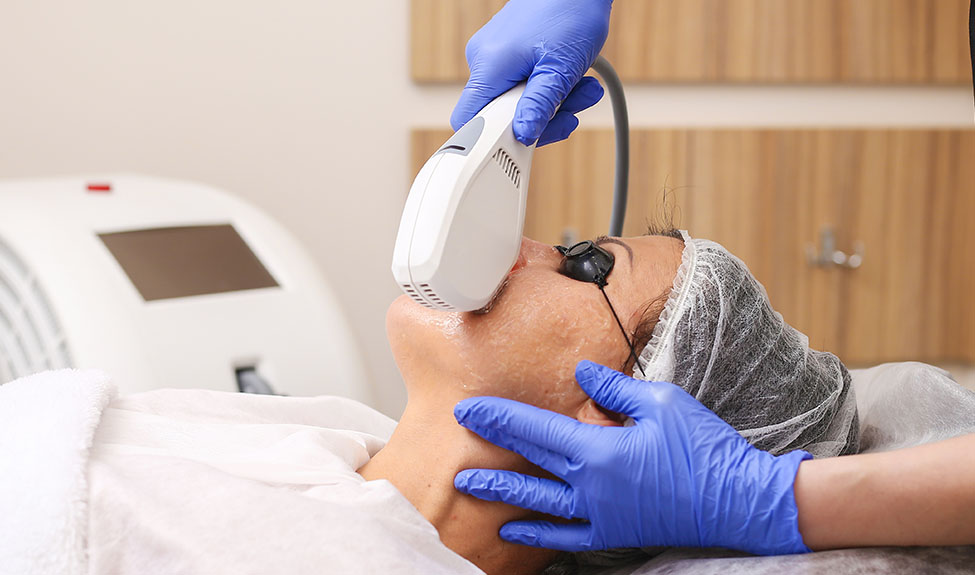Aging is inevitable, as are the visible signs it brings with it. Age spots, fine lines, sagging skin – these are all common concerns among spa clients.
Professional skin treatments can go a long way in resolving common skin concerns, but sometimes exfoliation and hydration are a good start but expanded care may be required. If your mature clients aren’t getting the results they want from your existing spa menu, consider making an addition: intense pulsed light (IPL) therapy.
This non-invasive treatment that can be used to reduce the appearance of age spots, sun damage, wrinkles and more. Here’s what you need to know about IPL and how to incorporate it into your spa.
The Basics of IPL Therapy
Intense pulsed light (IPL) therapy is similar to other laser treatment but instead of using one wavelength of light, it involves the release of many wavelengths similar to a photo flash. For this reason, IPL therapy is also referred to as a “photo facial”.
The light used in IPL therapy is less focused than a laser. It penetrates to the second layer of skin (the dermis) without harming the top layer, so it may cause less skin damage than other laser treatments. The pigment cells in the dermis absorb the energy from the light and convert it into heat which then destroys the hair follicle as well as unwanted pigment. It can be used on any part of the body but tends to work best in even areas of skin.
This type of therapy has the potential to provide the following benefits:
- Fade age spots and sun damage
- Reduce the appearance of freckles and birthmarks
- Repair varicose veins and broken blood vessels
- Improve symptoms of rosacea
- Remove hair from the face or body
- Reduce the appearance of fine lines and wrinkles
While IPL therapy certainly has its benefits, it’s not right for every client. For example, people with darker skin tones have a higher risk for hypopigmentation with IPL therapy and it isn’t recommended for individuals who are pregnant or those who have a chronic skin condition. It’s also important to inform clients of the potential side effects and complications.
What Are the Side Effects?
Any medical treatment comes with a risk for side effects. In most cases, the side effects of IPL therapy are minimal. Redness is a common side effect – it’s simply a sign of irritation and it generally goes away on its own after a few hours. Some patients also experience bruising, though it’s uncommon.
Clients undergoing IPL for the treatment of dark spots may find that their spots temporarily darken after treatment – some also experience hardening and flaking of the treated area. These effects typically don’t last more than a week, they will generally fade on their own.
In addition to these side effects, IPL has some risk for the following complications:
- Burns – It’s normal to feel some heat during the treatment, but the light should not burn when handled properly.
- Blistering – This is an unpredictable side effect and, in some cases, can be quite extensive or even painful for the patient.
- Scabbing – While flaking is natural as the melanin in the skin hardens, scabbing is a sign of damage to the epidermis.
- Hypopigmentation – More common in patients with darker skin tones, hypopigmentation occurs when patches of skin become lighter than the rest of the skin.
- Hyperpigmentation – This is when patches of skin become darker than the surrounding skin – it is different than dark spots which may get temporarily darker after treatment.
It’s important to inform clients that while IPL therapy is non-invasive, it is still a serious cosmetic procedure. It should only be performed in a qualified facility from a licensed medical professional.
Alternatives to IPL Therapy
If adding intense pulsed light therapy to your spa menu isn’t practical, there are several other options to consider. Here are 3 alternative treatments to consider:
Laser Therapy
This type of therapy comes in several forms. LED light therapy utilizes different wavelengths of light to reduce inflammation, treat acne, and minimize the visible effects of aging. Ablative laser therapy removes the epidermis, the thin outer layer of skin, and heats the underlayer to stimulate the production of collagen.
Microdermabrasion
A minimally invasive treatment, this procedure involves pricking the skin with myriad tiny needles. This creates micro-wounds which triggers the healing process and stimulates the production of collagen. Microdermabrasion can fade age spots and reduce the appearance of fine lines and wrinkles.
Fraxel Laser Treatment
A relatively new treatment, Fraxel laser treatment is a non-ablative treatment that penetrates the lower layers of skin without damaging the top layer. This treatment can help treat sun damage, reduce acne scars, and fade the appearance of fine lines and wrinkles.
If you’re considering adding IPL or other treatments to your spa menu, be sure your facility is approved, and your staff is properly trained and licensed. Once you’ve made the required arrangements, you can start offering IPL therapy as a standalone service or an upgrade to existing treatments.

